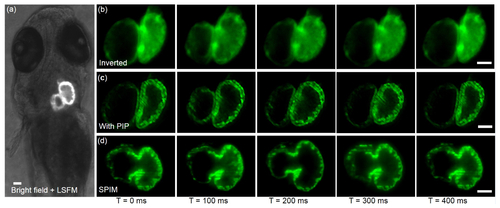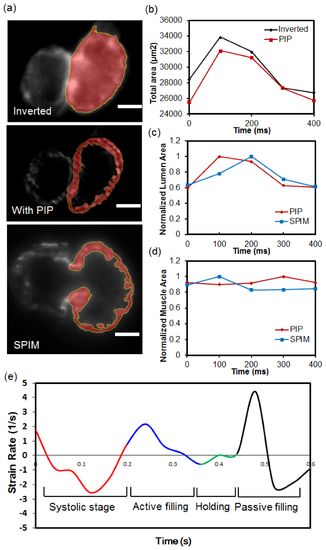- Title
-
Compact plane illumination plugin device to enable light sheet fluorescence imaging of multi-cellular organisms on an inverted wide-field microscope
- Authors
- Guan, Z., Lee, J., Jiang, H., Dong, S., Jen, N., Hsiai, T., Ho, C.M., Fei, P.
- Source
- Full text @ Biomed. Opt. Express
|
Contrast-enhanced light sheet imaging of beating embryonic zebrafish heart by PIP mounted microscope. (a) Light sheet sectioning inside a live embryonic zebrafish heart (4 d.p.f., Tg: (cmlc: gfp)). PIP enables the selective plane illumination on specific region of interest of the beating heart. (b) and (c) show the image comparison between regular inverted microscope and PIP mounted inverted microscope. The dynamic inner and outer boundaries of the beating heart can be clearly resolved when PIP is added. (d) shows the control heart images (same stage embryo) from a home-built, standard SPIM system with identical illumination and detection settings of PIP imaging. Scale bars in all images are 50 µm. |
|
Quantifying the area dynamics of beating embryonic zebrafish heart. (a) Segmentation of the ventricle’s inner and outer boundary. In the wide-field fluorescent image, due to the out-of-focus blur, only the outer boundary of the ventricle can be identified (yellow line). In PIP and SPIM images, by significantly enhancing image contrast, the inner boundary as well as ventricle’s myocardium structure (red area) can be accurately segmented. Scale bars in all sub-graphs are 50 µm. (b) The calculated area variation of the complete ventricle area in 400 millisecond time. (c) The normalized area change of the inside fluid domain, which is only enabled in PIP and SPIM image results. (d) The corresponding area change of the segmented ventricle muscle during heart beating. (e) The strain rate of the beating embryonic zebrafish heart during a cardiac cycle. The strain under each time point was calculated based on the girth variation of the ventricle inner boundary. |


